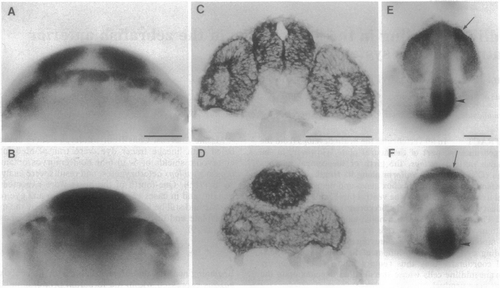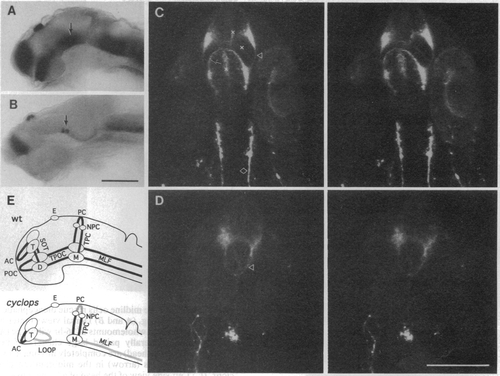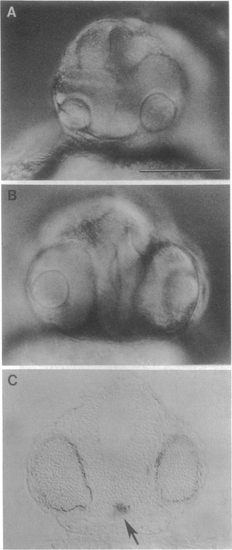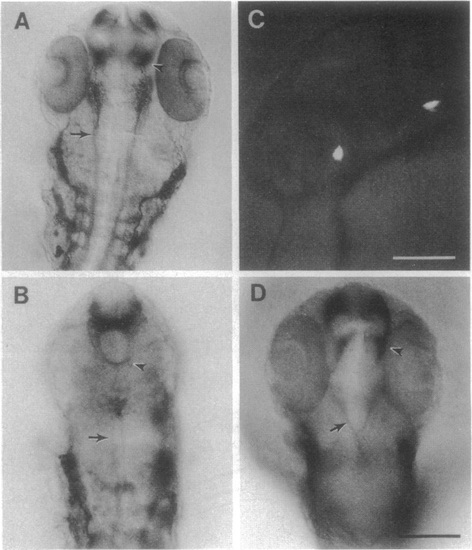- Title
-
Midline signaling in the primordium of the zebrafish anterior central nervous system
- Authors
- Hatta, K., Püschel, A.W., and Kimmel, C.B.
- Source
- Full text @ Proc. Natl. Acad. Sci. USA
|
cyclops alters the patterns of pax6 (A-D; in situ hybridization) and pax2 (E and F; immunolabeling) expression in the forebrain. (Upper) Wild-type embryos. (Lower) Matching homozygous cyclops mutants (cycb16; ref. 7). (A) Frontal view of whole mount at 11 hr postfertilization at 28.5°C showing the forebrain region of the wild-type neural plate. Two bilateral domains of pax6 expression are separated by a median area free of expression. (B) In cyclops, a single domain spans the midline. (C) Transverse section at 24 hr of the wild-type forebrain and eyes. pax6 expression is present in the retinas and along about two-thirds of the dorsolateral walls of the diencephalon. Expression is absent in a large ventral region and in the roof plate. (D) In cyclops, the area normally devoid of pax6 in the ventral diencephalon is entirely missing, and the retinas are fused under the diencephalon. The roof plate remains free of expression. (E) Dorsal view of the head of a wild-type whole mount at 18 hr immunolabeled with anti-Pax2 antibody. Anterior brain is at the top. Cell nuclei are labeled in bilateral patches around the anterior edges of the optic stalks (arrow) and in a band at the presumptive midbrain-hindbrain junction area (arrowhead). (F) In cyclops, the two domains of labeling in the optic stalks are weaker and are fused ventromedially (arrow). There is no obvious change in labeling at the midbrain-hindbrain junction (arrowhead). (Bar = 100 μm.) |
|
cyclops alters neuronal and axonal organization in the anterior brain. Immunolabeled whole-mount preparations at 26 hr, with wild-type embryos above and mutants below. (A and B) Left side views (dorsal up) of whole-mounted wild-type embryo (A; eye removed by dissection) and mutant embryo (B; cyclopic eye present ventral to the forebrain) labeled with the monoclonal antibody zn-1, revealing neuronal cells (15). cyclops deletes the ventral diencephalic cluster and reduces the size of the midbrain cluster (arrows). The prominent telencephalic neuronal cluster (to the left) and the smaller epiphyseal cluster in the dorsal diencephalon (upper) are present in wild types and mutants alike. (C and D) Stereo-pair confocal microscopic views (from the ventral aspect, anterior brain at the top) of embryos labeled with the monoclonal antibody zn-12 (16) to show neuronal groups and axonal pathways. The postoptic commissure is prominent in the wild type (arrow in C) but is missing in the mutant (D), and the supraoptic tracts (arrowheads) connect together in an abnormal loop across the midline. In the wild type, the medial longitudinal fascicles form prominent posteriorly directed tracts (diamond) from paired midbrain neuronal groups, but these tracts are absent in this example of the mutant, and the midbrain neurons occupy a single midline cluster. x, Labeling of neuroepithelial cells, not axonal fascicles. (E) Left-side summary views of the neuronal and axonal deficiencies. Tracts that are variably present or absent in cyclops are indicated by gray lines. In cyclops, the anterior commissure (AC) is shortened, the supraoptic tracts (SOT) frequently (in 70% of the cases, n = 24) form an abnormal commissural loop posterior to the fused optic stalk. The posterior commissure (PC) was present in 40% of the mutants (n = 24). D, ventral diencephalic neuronal cluster; E, epiphyseal cluster; M, midbrain cluster; MLF, medial longitudinal fascicle; NPC, nucleus of the posterior commissure; POC, postoptic commissure; T, telencephalic cluster; TPC, tract of the posterior commissure; TPOC, tract of the postoptic commissure. (Bars = 100 μm.) |
|
Wild-type midline cells rescue cyclopia and forebrain morphogenesis in mosaics. (A) Face view of a mosaic embryo in which transplanted wild-type cells (not shown) were restricted to the trunk. The head is typically mutant in appearance. (B) Face view of a mosaic embryo in which the head morphology is essentially completely normal. However, the host was a cyclops mutant, as ascertained from the phenotype of the trunk and tail. A total of about 10 labeled wild-type cells (not shown) were present in the ventral midline of the forebrain and in the head periphery and hatching glands, which derive from the prechordal plate. (C) Transverse section through the head of another mosaic in which lateral eyes were restored (the retinal pigmented layer appears dark), and the forebrain was partially rescued by three or less biotin-labeled wild-type cells (arrow) in the midline of the ventral diencephalon. (Bar = 100 μm.) |
|
Wild-type midline cells rescue diencephalic neurogenesis and axonal patterning. (A and B) Dorsal views (anterior brain at the top) of zn-12-labeled wholemounts of 26-hr wild-type (A) and cyclops (B). Normally bilaterally paired large clusters of neurons in the diencephalon (arrowhead) are completely missing in cyclops. Medial longitudinal fascicles (arrow) in the midbrain are disrupted in cyclops. (C) Left side view of the head of a living mosaic embryo, with two small clusters (ca. 2 cells each) of rhodamine-conjugated dextran- labeled transplanted wild-type cells. The cluster to the left is at the ventral midline of the diencephalon, just posterior to the eye; the other cluster is ventral to the anterior hindbrain. A few donor cells were also present in the hatching glands and lateral hindbrain but are not visible here. (D) The same mosaic embryo fixed and labeled with zn-12; the view is as in A and B. The eyes and forebrain and midbrain neuronal and axonal patterning are rescued, but not the hindbrain or spinal cord. Diencephalic neuronal clusters (arrowhead) are present; medial longitudinal fascicles (and their nuclei) are separated in the midbrain as in normal embryos but come together and fuse ventrally in the hindbrain as in mutants. (Bar = 100 μm.) |




